MonitorWare Agent 7.3a Released
Release Date: 2011-05-16
Build-IDs: Service 7.3.402, Client 7.2.0.1326
Bugfixes |
|
You can download Free Trial Version of MonitorWare Agent.
Log Consolidator and Alerter
Release Date: 2011-05-16
Build-IDs: Service 7.3.402, Client 7.2.0.1326
Bugfixes |
|
You can download Free Trial Version of MonitorWare Agent.
Build-IDs: Service 8.0.411, Client 8.0.1342
New Additions |
This action can send messages to the Microsoft Message Queuing Server. It is possible to customize the Queue Label, Priority and Queue Body. The Queue Body contains the message property by default as UNICODE (UTF16) string. In order to use this action, you need to have the Microsoft Message Queuing (MSMQ) Server installed. Support for IPv6 has been added into all network related facilities of the engine. All network related actions will automatically detect IPv6 and IPv4 target addresses if configured. You can also use DNS resolution to resolve valid IPv6 addresses. Network related Services can either use IPv4 or IPv6 as internet protocol. In order to support both protocols, you will need to create two services. The only exception is the RELP Listener, which uses IPv4 and IPv6 automatically if available. Added support for accepting connections using the extended SMTP EHLO command. Extended MonitorWare SETP Protocol to V3. If Sender and Server support V3 or higher, UTF8 is now used to encode/decode messages. This maintains the correct character encoding after the messages is received and rebuild internally. Implemented OutputEncoding for 8Bit (var)char fields. This means we can now write UTF8 encoded messages into varchar fields. Added option to add ProcID into SyslogTag for RFC 5424 Header parsing. This was previously default. The Option is disabled by default now making it easier to filter for the SyslogTag. Added option to Force UTF8 Decoding in Syslog Service. A new Encoding configuration tab lets you decide, if you which to automatically detect the encoding, force UTF8 decoding, or use system default encoding. Added Performance fix for UTF conversion for empty strings. Enhanced SSL Security in all network related Services. Added support for polling EventLog Records. This works almost like in the old EventLog Monitor, the Eventlog channel is polled frequently and new EventLog records are processed only. By default, the “Subscription Model” is used which processed events in Realtime. Added support to read and process EVTX files. This requires the new “Eventlog Polling” method. It is also possible to update the EVTX files while MonitorWare Agent is running. Added support for IPv4/IPv6 and TCP/UDP. A combination of UDP/TCP and IPv4/IPv6 can now be configured. Continue reading “MonitorWare Agent 8.0 Released (Build-IDs: Service 8.0.411, Client 8.0.1342)” |
Adiscon is proud to announce the 8.0 release of MonitorWare Agent. This new major release focusses on international support. First of all, it now provides full IPv6 support throughout the complete engine, including all services and actions. This provides an easy transition to the new protocol just in time when the migration becomes more important to many customers. Also, the new release provides far better support for Unicode, both in messages being processed as well as internal handling, like the write to database actions.
The improved Unicode support increases interoperability for example in Asia. Not only is it easier to have the correct character set persisted to files and databases, it now also is possible to send Unicode via RFC5424-formatted messages to standards-compliant remote hosts.
The new IPv6 support is currently of most benefit for customers in countries with very limited IPv4 address ranges. However, it enables a smooth transition to the new protocol to customers everywhere. It is considered an important milestone towards the next generation of the Internet.
In addition to these top features, the new version includes additional new capabilities, like native support for backup EVTX files. There are various use cases for this capablity. An important one is that some SAN devices export their event log in the form of an ETVX file, which now can natively be read by EventReporter. The new release also contains some bug fixes.
The new version also includes additional new capabilities, like native support for the Microsoft Message Queuing Server. It also contains some bug fixes.
Detailled information can be found in the version history.
Version 8.0 is a free download. Customers with existing 11.x keys can contact our Sales department for upgrade prices. If you have a valid Upgrade Insurance ID, you can request a free new key by sending your Upgrade Insurance ID to sales@adiscon.com. Please note that the download enables the free 30-day trial version if used without a key – so you can right now go ahead and evaluate it.
Adiscon is proud to announce the 7.3 release of MonitorWare Agent. This is a bugfixing release.
This release only consists of bugfixes:
For more details read the version history
Version 7.3 is a free download. Customers with existing 6.x keys can contact our Sales department for upgrade prices. If you have a valid Upgrade Insurance ID, you can request a free new key by sending your Upgrade Insurance ID to sales@adiscon.com. Please note that the download enables the free 30-day trial version if used without a key – so you can right now go ahead and evaluate it.
Release Date: 2011-04-05
Build-IDs: Service 7.3.401, Client 7.2.0.1326
Bugfixes |
|
You can download Free Trial Version of MonitorWare Agent.
We still need to implement the Linux clients into our logging network. This could be Linux workstations or servers. Currently, rsyslog is already shipped with many Linux Distributions as the default syslog daemon already. Though, often a rather old version is installed (mostly v3), this will be sufficient for our current goals.
For our example we will use a Fedora system and alter the configuration accordingly. In the end, rsyslog should use the logs, that are logged locally and forward them via TCP to the central log server.
Please note: The example has been made with Fedora 13. Some steps may vary with other Linux distributions. Since there are so many possibilities, we cannot list them all. So we only concentrate on one version.
First of all, we need a terminal or command line and go into root mode with su. We do not need the root rights desperately, but it is a bit easier to achieve our goals.
We need to alter the configuration accordingly. We will use the vi text-editor to do so. If you are not familiar with vi, you should consider getting some knowledge first with the vi man page.
You can find the default configuration file in
/etc/rsyslog.conf
This configuration file will be loaded once rsyslog is started.
Open the configuration file by the following command:
vi /etc/rsyslog.conf
Your terminal should look like this:
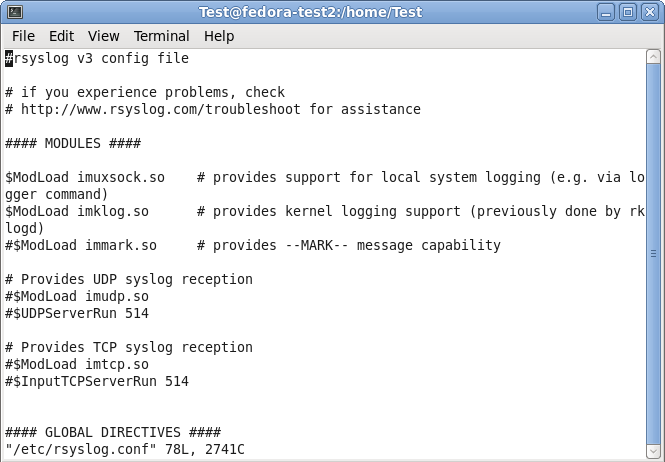
Under the header “#### MODULES ####” you can see the loaded modules. The ones we need are already loaded. For sending syslog, we do not need a extra module to be loaded. Basically, the imuxsock.so is listening to the local log socket and imklog.so provides the support for kernel logging. More is currently not needed.
When going further down in the configuration, we see parts that are called UDP and TCP syslog reception. They are uncommented. We don’t need them, so we leave them that way. As you can see, there is the command to load a module (introduced my $ModLoad) and then a specific command that is given to the module which tells it to run as a syslog server on a specific port.
When scrolling further down in the configuration file, we will find the header “#### RULES ####“.
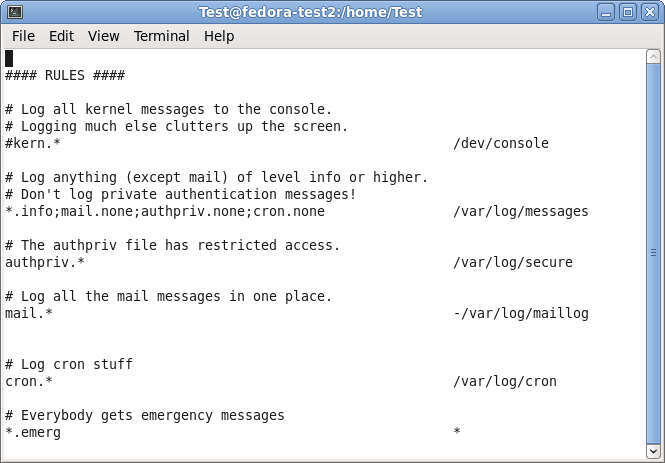
Here, some rules are defined about which logs are stored in which location. These rules have a basic format. Basically, this looks like this:
facility.severity storage_location
The facility roughly determines, what has generated the log message. The severity tells you, how urgent the message is. And the storage location determines, where to store the logs. In the default config, there are several rules for some important log files. They will all be stored in the folder /var/log.
We need to add another rule for forwarding all log messages via TCP syslog. For now, go to the last of the rules and insert the following:
*.* @@central_server:10514
This rule means that all messages, no matter the facility or severity, will be forwarded via TCP to the central server on port 10514. We need to choose port 10514, since our central server will listen to TCP syslog on this port.
In the configuration file, this should look like this:
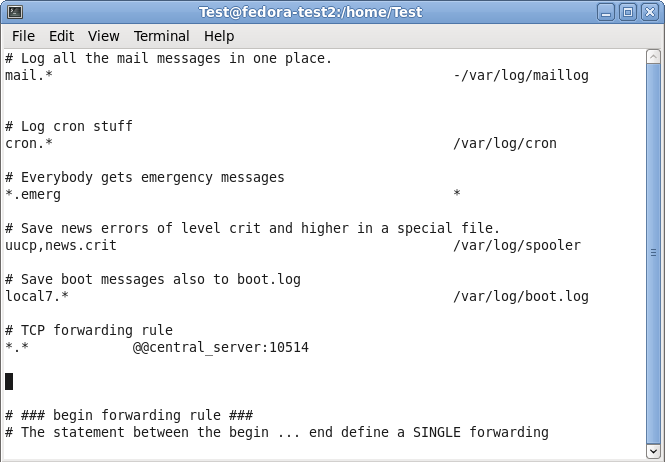
You can now save and quit vi.
Now that we have altered our configuration according to our needs (which hasn’t been too much), we still have one more thing to do. We need to restart the service.
Now that we are back on the command line, we can easily use the following command:
service rsyslog restart
This will tell the rsyslog service to stop and start again. Thus, the configuration will be loaded with the changes we made.
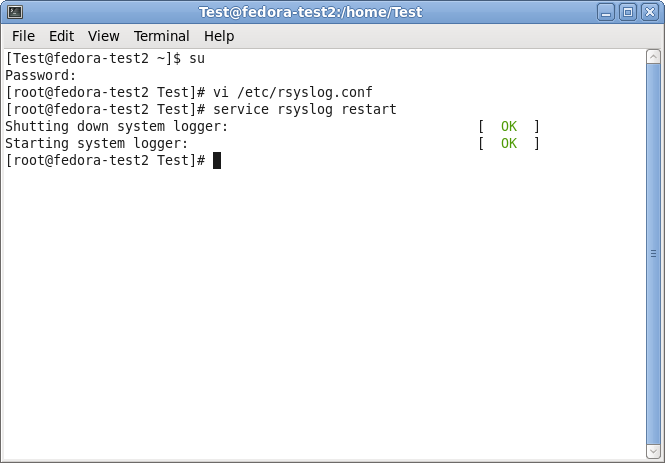
We are now finished with setting up rsyslog correctly. It will take all the logs it receives and forwards them to our central log server via TCP on port 10514. In addition to that, the default log rules still exist and will log messages to the local harddrive.
Though, there could be many more scenarios and configurations. We decided to keep it simple for a basic setup.
We already have the central server and the regular Windows clients set up. We now need to set up the other Windows servers. We assume, that we have other Windows 2008 Servers. On these servers we want to monitor the local Event Log and textfile-based log files. The log messages shall be transferred to the central server via TCP again.
To achieve this, we need MonitorWare Agent installed on those servers. This is simply because it is able to monitor textfiles in addition to the regular Event Log. In addition to MonitorWare Agent, we need nothing to be installed. Since we want to monitor textfile-based log files, we assume there is an IIS running.
First, we will set up the ruleset. By doing this, we can create the services and they will automatically bound to the ruleset.
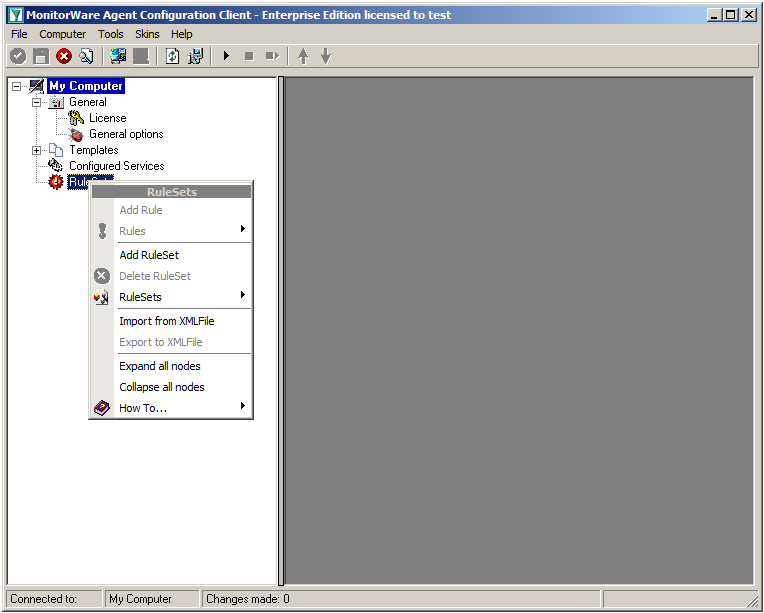
Right-click on RuleSets in the left hand list. A context menu will appear. Click on Add RuleSet
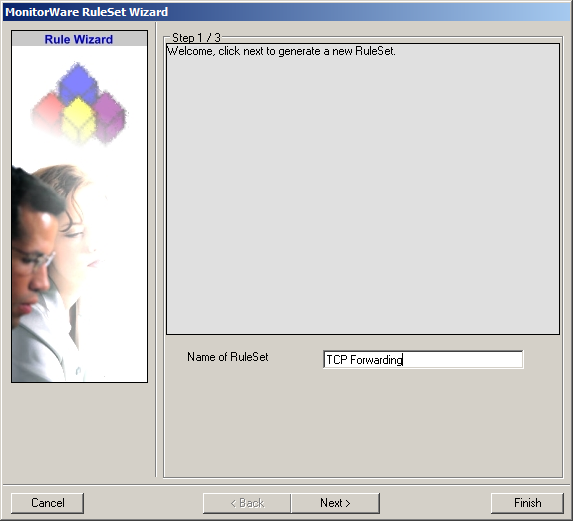
The RuleSet Wizard will appear now. You can give your ruleset a name of course. We will use TCP Forwarding for this example. After that, click on “Next”.
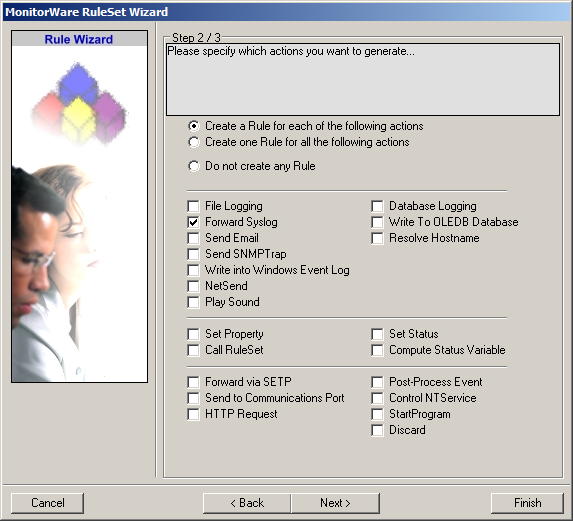
On the second page of the wizard we can specify what actions we want. Since we only want the log messages to be forwarded via syslog, check the box next to “Forward Syslog”. After that, click “Finish” to create the ruleset and action.
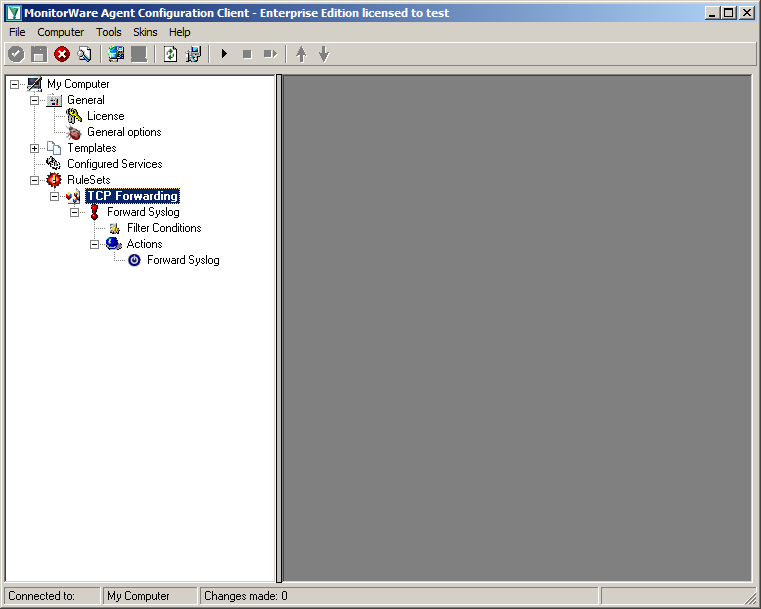
When you expand the treeview now, you will find a rule named “Forward Syslog” with an attached action of the same name.
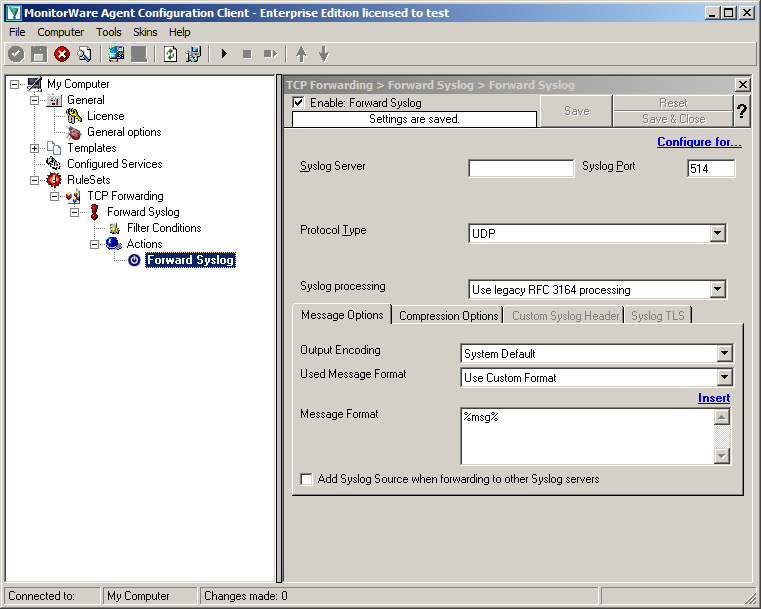
Now click on the action “Forward Syslog. You can see the default values now.
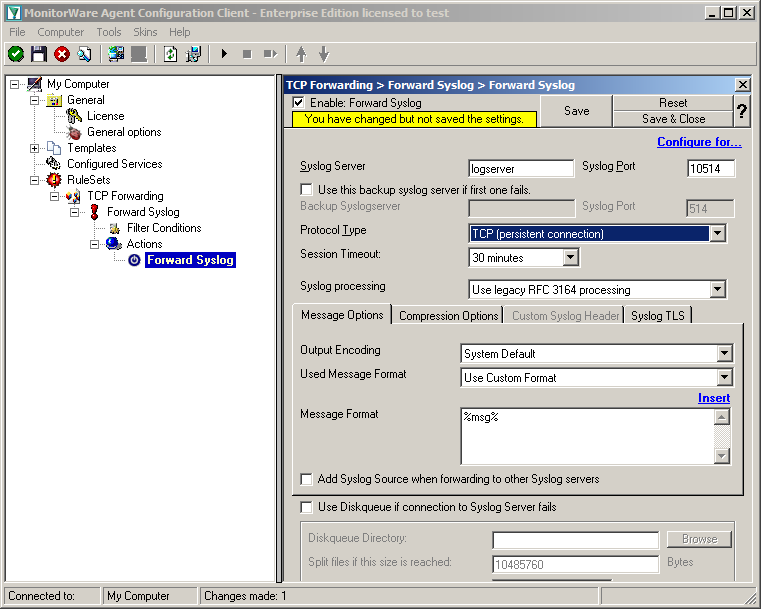
We need to change some of those settings now. First of all we need to enter the IP or hostname of our central server into the field “Syslog Server”. After that, change the port to 10514, since our central server will listen to syslog on this port. And we need to change the protocol type. Change is to TCP (persistent connection). That is all for now. Click on the Save button on the top so we can go on configuring the Service itself.
Currently, when clicking on Configured Services you will not see a thing. But we will configure the services now. Without them, MonitorWare Agent is not able to get any log messages. We will setup 1 EventLog Monitor and 1 File Monitor.
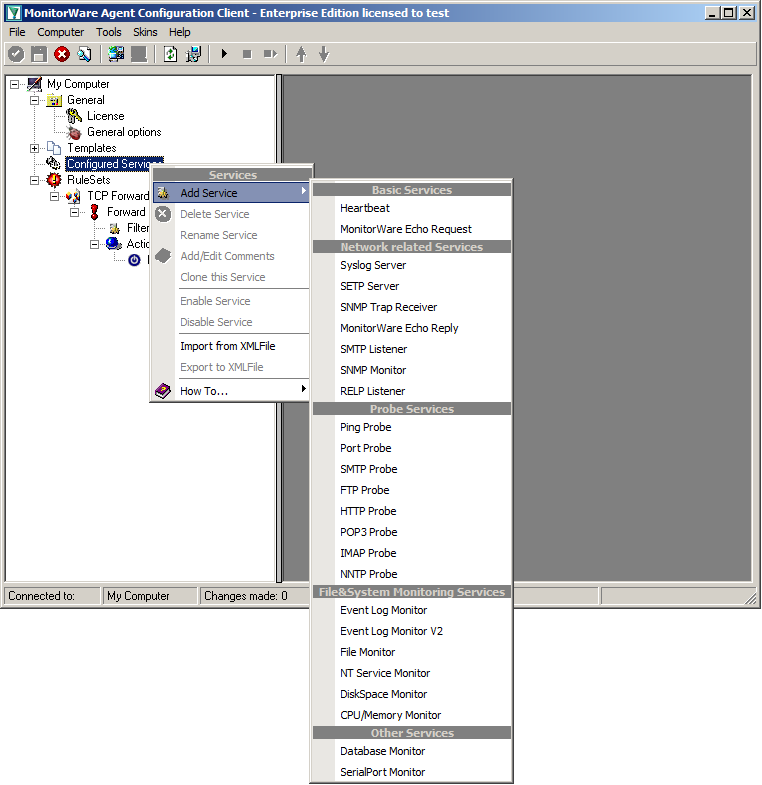
When right clicking on Configured Services a context-menu will open. By moving your cursor to “Add Service” you can see a list of Services, that may be configured. The list seems pretty long, but we basically need 2 services of them.
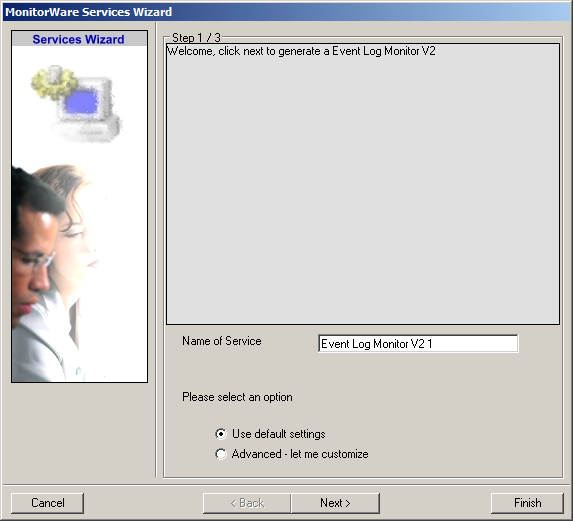
Click on “EventLog Monitor V2” first. The Services Wizard will open. Simply click on Finish for now. Repeat this again for the File Monitor.
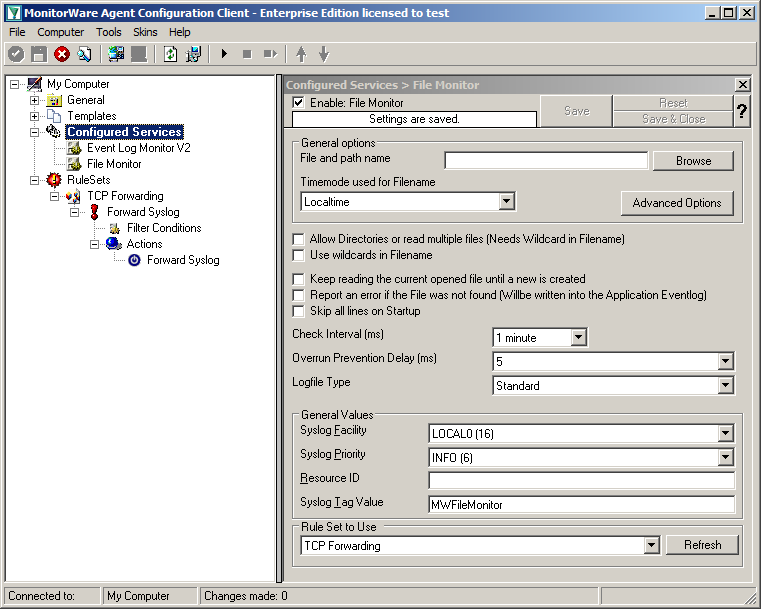
In the end, you should have a list with 2 Services. For our example I renamed the services by doing a right-click on the Service name I wanted to change and the choosing “Rename Service”.
Settings for Event Log Monitor V2
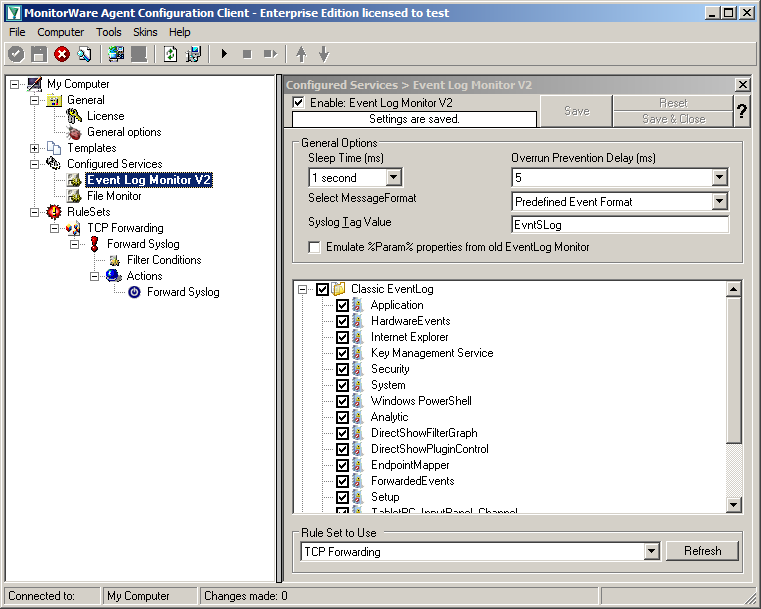
The Event Log Monitor V2 needs no additional setup. Again the default values are ok. If you want specific Event categories not to be stored, you can disable the options. But the basic format is sufficient.
Settings for File Monitor
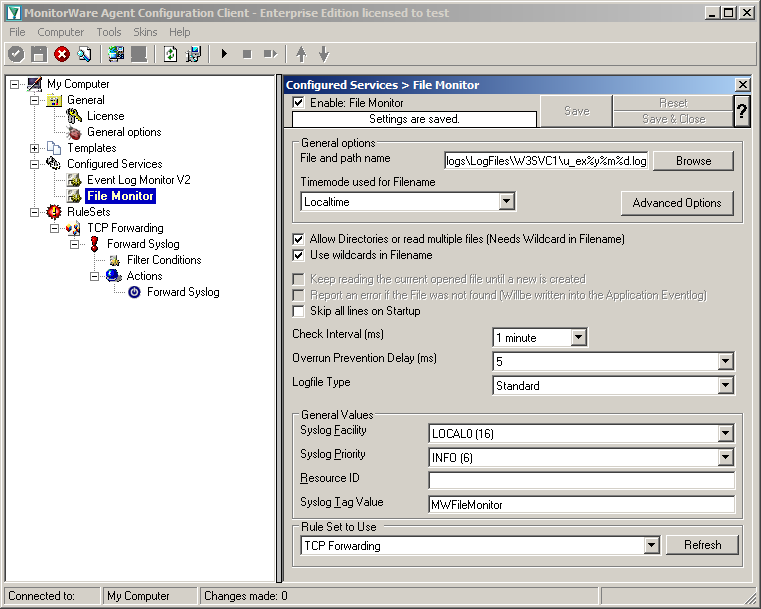
The File Monitor needs some additional settings. First, enable the option “Allow Directories or read multiple files”. You will see, that the use of wildcards will be automatically enabled and some other options completely being disabled.
Then we need to set the source files. For our example, we want to monitor the IIS logfiles. At the top of the File Monitor configuration you can see the option “File and path name”. There is a Browse button right next to it. Click it.
A windows explorer window will open, where you can choose the file you want to monitor. Navigate to the path C:\inetpub\logs\LogFiles\W3SVC1\. This is the location where the log files are stored. Please note, that the file location could be different when using another version of IIS. Choose the first file in the list. (Note: Daily Internet Information Server log files are named “u_exyymmdd.log”, with yy being the 2 digit year, mm the month and dd the day of month. To generate the same name with file monitor, use the following name “u_ex%y%m%d.log”.)
Set the Logfile Type to “W3C WebServer Logfile”.
Please note, that this step can be easily adapted for other log files (e.g. DHCP log files) as well.
We have now finished setting up the other server. You only need to Save the configuration and start the Service with the “Play” button at the top of the Configuration Client. MonitorWare Agent will pull the logs from the Event Log and the text files and forward them via TCP syslog to our central log server.
Setting up the Windows Clients is rather easy. To do this, we only need to have EventReporter installed. EventReporter will be configured to pull the Windows Event Logs and forward them to our central syslog server via TCP syslog. Our example system will be Windows XP.
When you open the Configuration Client, you will see the configuration tree on the left. Most important are the part “Configured Services” and “Rulesets”. Right now, both have no content. But we will change that now.
As a first step, we will set up the ruleset again.
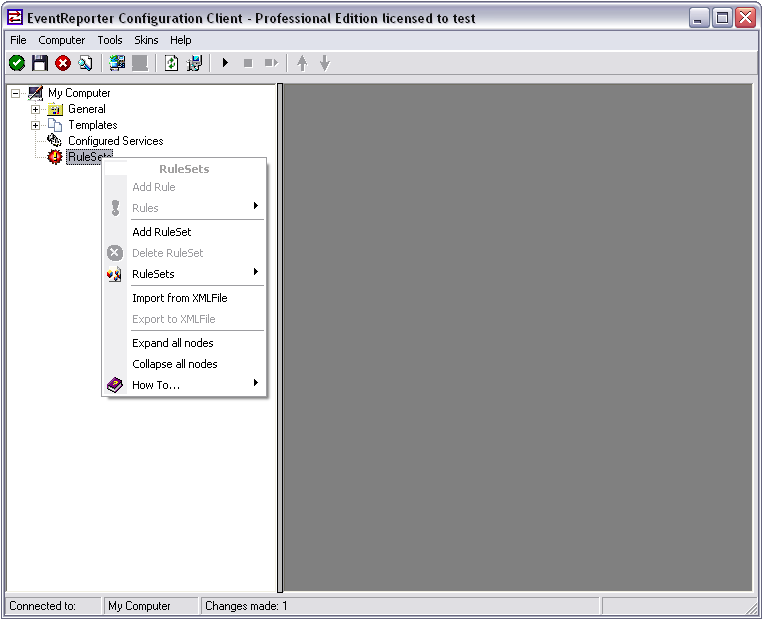
Right-click on RuleSets in the left hand list. A context menu will appear. Click on Add RuleSet
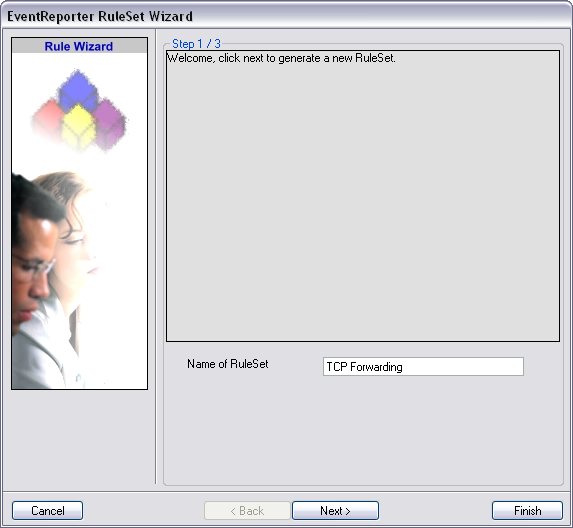
The RuleSet Wizard will appear now. You can give your ruleset a name of course. We will use TCP Forwarding for this example. After that, click on “Next”.
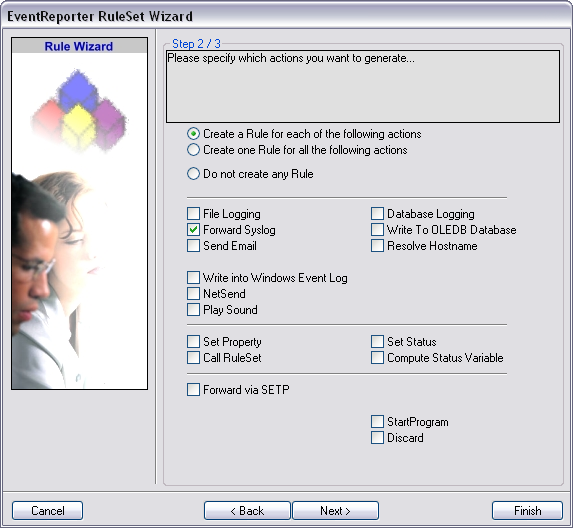
On the second page of the wizard we can specify what actions we want. Since we only want the log messages to be forwarded via syslog, check the box next to “Forward Syslog”. After that, click “Finish” to create the ruleset and action.
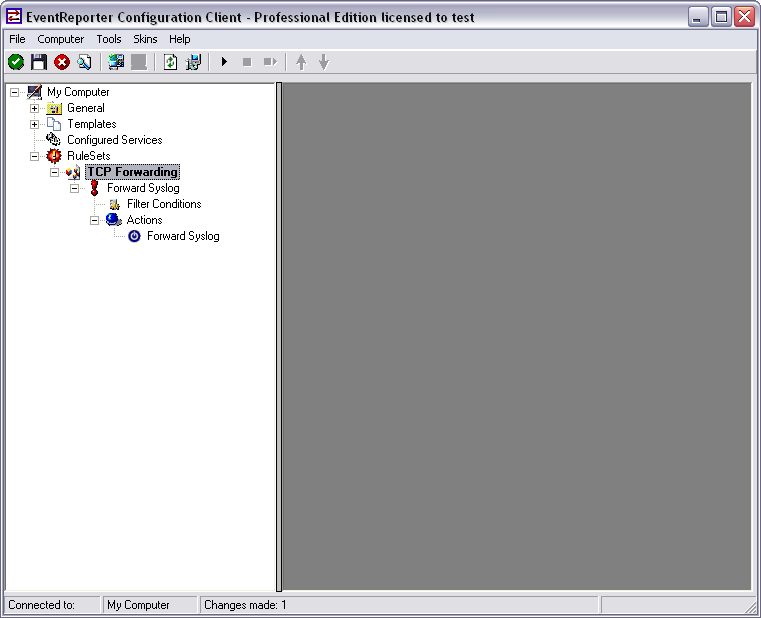
When you expand the treeview now, you will find a rule named “Forward Syslog” with an attached action of the same name.
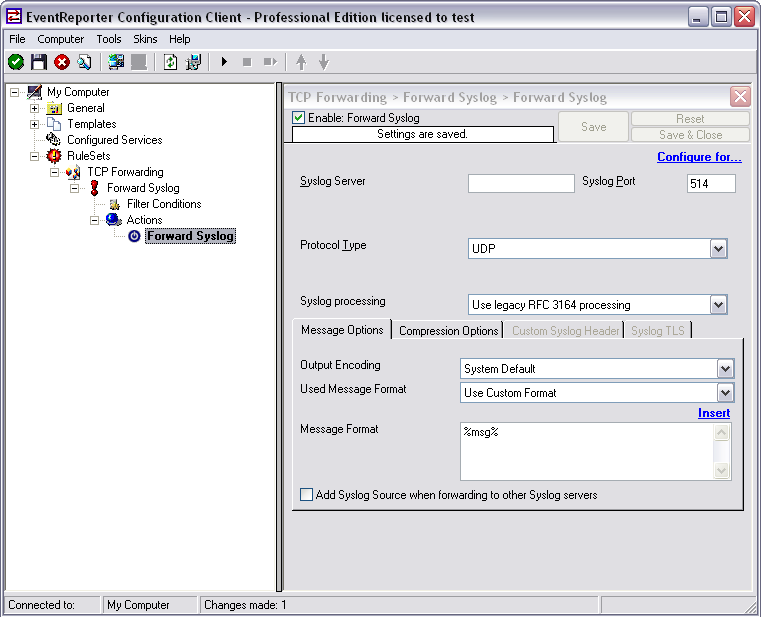
Now click on the action “Forward Syslog. You can see the default values now.
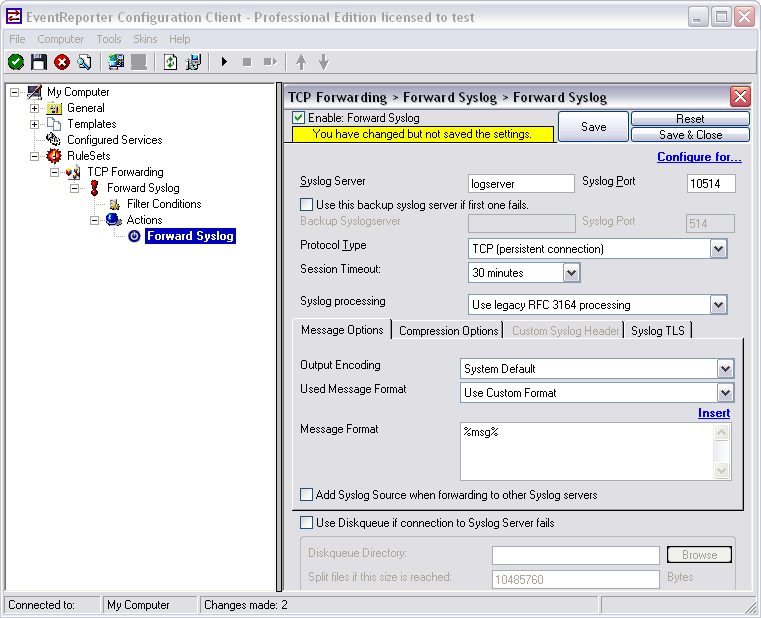
We need to change some of those settings now. First of all we need to enter the IP or hostname of our central server into the field “Syslog Server”. After that, change the port to 10514, since our central server will listen to syslog on this port. And we need to change the protocol type. Change is to TCP (persistent connection). That is all for now. Click on the Save button on the top so we can go on configuring the Service itself.
We need to configure our service now. Right-click on “Configured Services” in the configuration tree on the left to pop up a context menu.
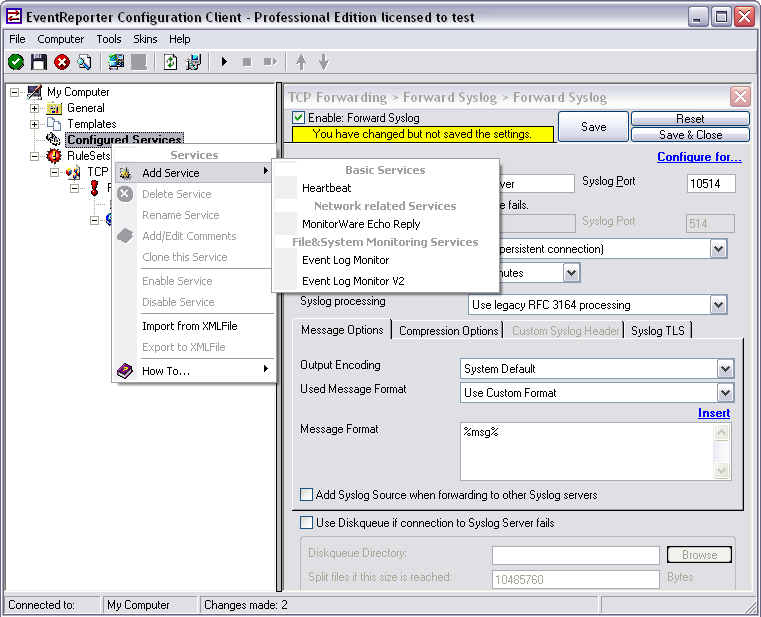
When you go to “Add Service” you will see the list of available Services. The list is a lot smaller than in MonitorWare Agent. We need the regular Event Log Monitor in this case.
Note: If you are using Windows Vista, 7 or Server 2008 you might consider using the Event Log Monitor V2, since it is optimized for the new EventLog that has been introduced with Windows Vista.
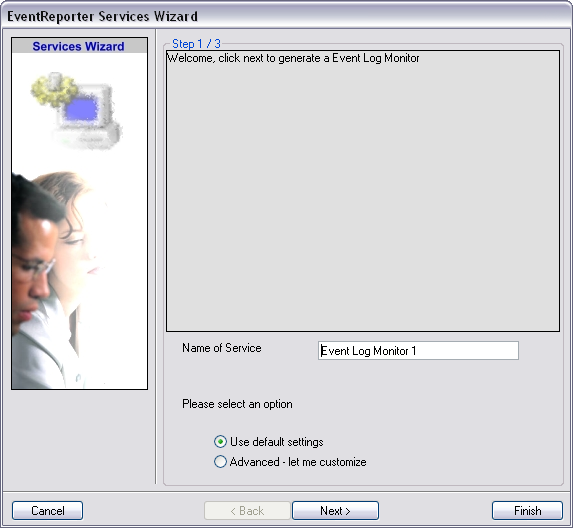
When you have clicked on Event Log Monitor in the list, a wizard will open. Since we will not do any configuration now, just click on “Finish”.
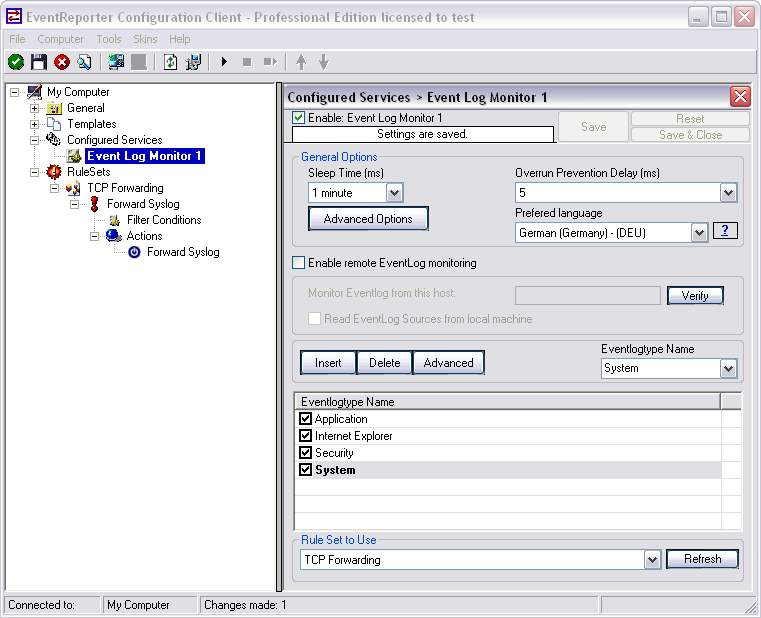
When clicking on Event Log Monitor in the configuration tree you will see the default options. We can leave these settings as they are. Probably you might want to change the preferred language or the sleep time. As you can see at the bottom, the service is already assigned to our ruleset we created earlier. Newly created services will automatically be assigned to the first ruleset in the list.
Basically, that is it. Save the configuration and then start the service with the button that looks like the “Play” symbol. EventReporter will then start to pull Events from the Windows Event Log and forward them via TCP syslog to your central server.
The central log server is the most important part of our central log storage and thus will be configured as the first part. And due to all the things it needs to do, it has the most work of course. When selecting your machine to install the central log server on, please keep in mind, that you need quite a good machine for larger networks. If you have a very large environment, it might be a good idea to use multiple servers for this scenario with a load balancer and a separate database server. But in this guide, we will have it all on one machine.
Prerequisites:
The following should be installed and working:
The list holds the things necessarily needed. In the brackets is schon which we will use in this example. Please note, that this will work with other versions as well, especially with MonitorWare Agent.
As mentioned before, MonitorWare Agent will have multiple purposes. It should receive syslog via TCP and UDP, monitor the local EventLog and textbased logfiles as well as writing everything into a database and sending email messages in case of error and critical messages occuring.
First of all, we will set up the processing rules and actions. We will start this way due to the design of MonitorWare Agent. Since the Services need to be bound to a ruleset upon creation, we will start this way, so the ruleset is there already when creating the service.
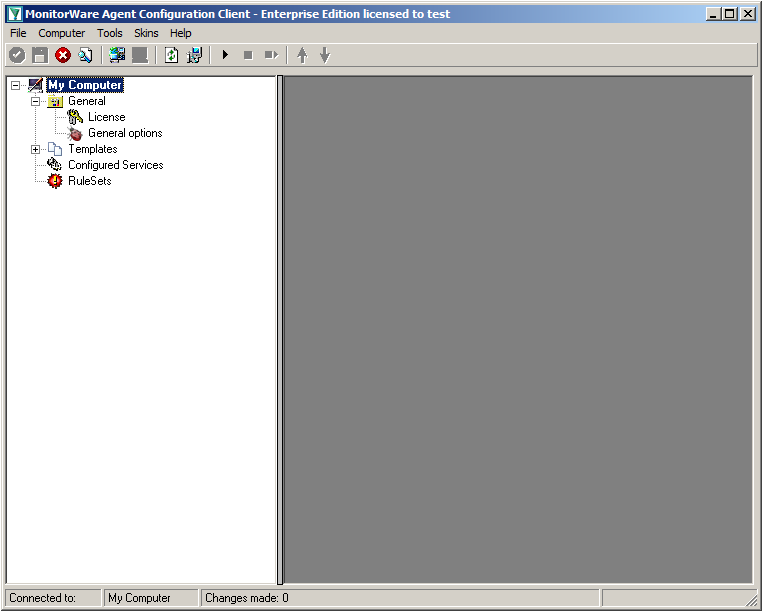
When starting MonitorWare Agent the first time, you will see on the lefthand side our overview of “Configured Services” and “Rulesets”. Right now, there shouldn’t be any entries here.

Right click on “Rulesets”. A context-menu will open.
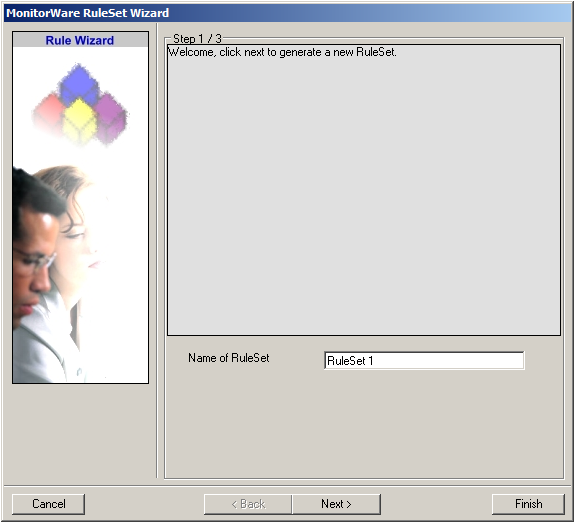
Choose “Add Ruleset”. The ruleset wizard will open. On this first screen, we can choose the name of the ruleset.
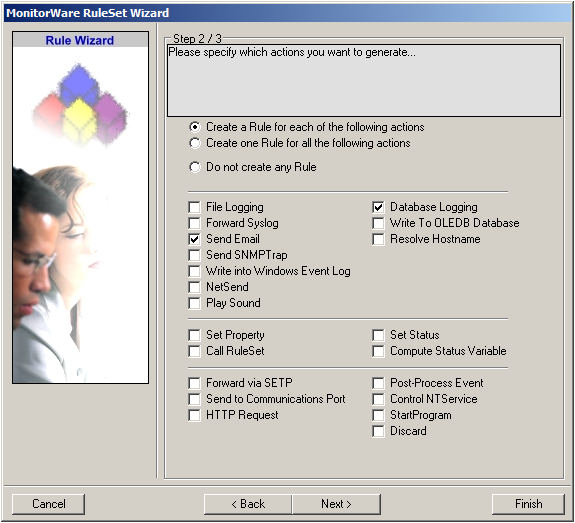
After choosing a name (in this example “Storage & Alert”), click on “Next”. Here we can set, what we will need. Leave the marker for “Create a Rule for each of the following actions” and choose “Send Email” and “Database Logging”.
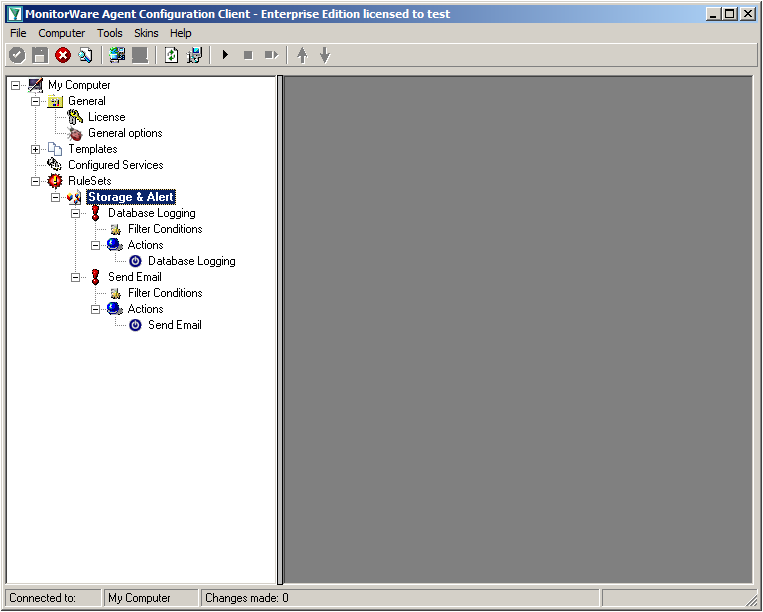
You can now click on Finish. You will now see a new ruleset in the treeview on the left hand side. If you expand this view completely, you can see the two rules that have been created and the actions that are in there. You should have a rule “Database Logging” and a rule “Send Email”.
We will now start with configuring the action for “Database Logging”. Expand the branch called “Database Logging” completely. Under actions you will find the “Database Logging” action. When you click it, you will see the configuration window.
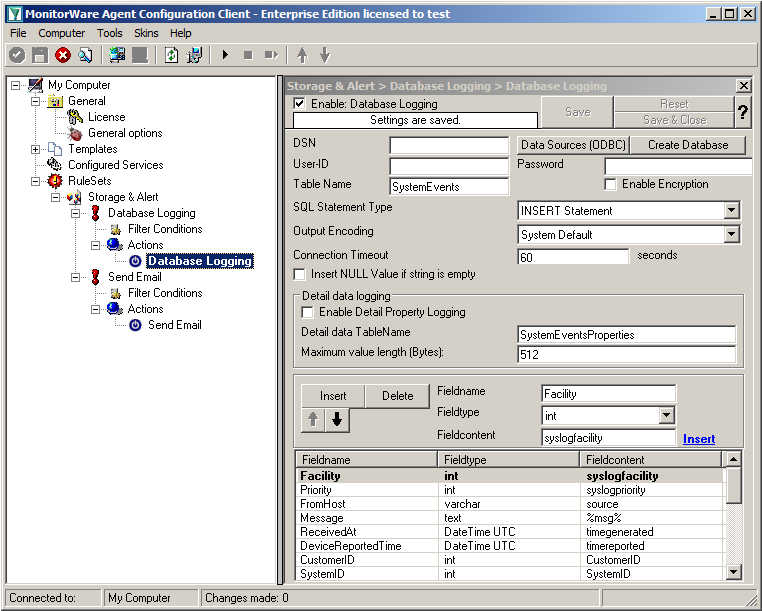
Click on the button “Data Source (ODBC)”. This will open the ODBC Data Source Administrator.
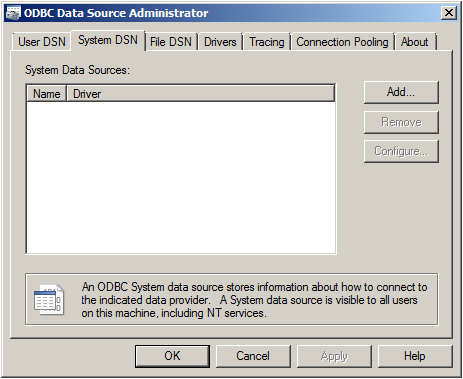
Go to System DSN and click “Add…”.
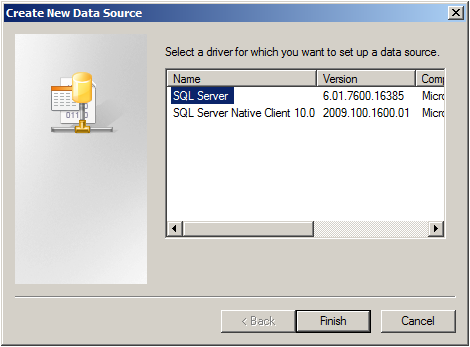
Select SQL Server from the list and click “Finish”.
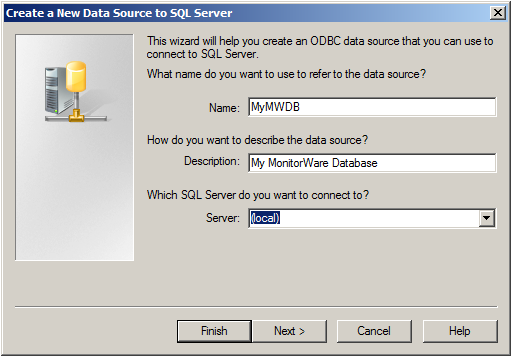
Choose a name for the datasource and a description. In this case we choose MyMWDB as name. As server choose the name of the server where the database is. In our example we use localhost. Now click on “Next”.
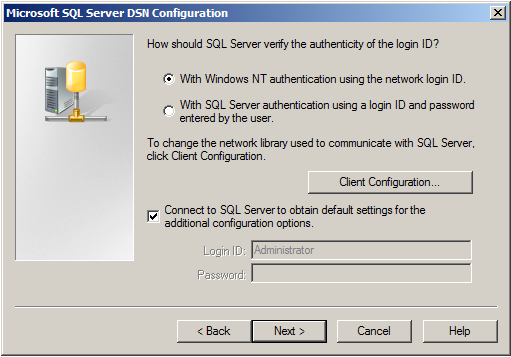
Select “SQL Server Authentication” and type in your MSSQL Login ID and Password. If you have Windows NT authentication like in our case, leave it as is. Click on “Next”.
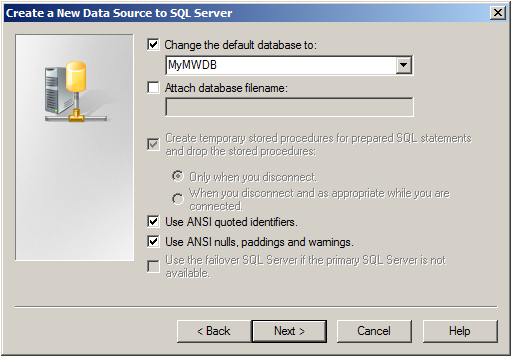
Select “Change the default Database to:” and choose your new created Database, in our example we use “MyMWDB” which we created beforehand. Click on “Next”.
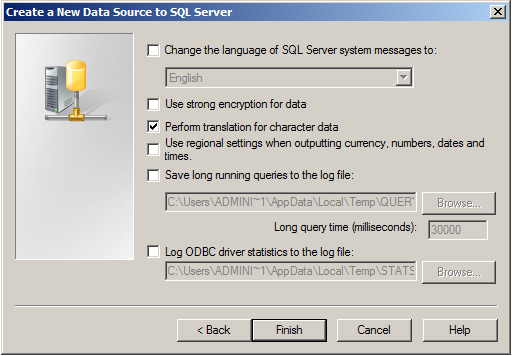
Leave all at default settings and click “Finish”, a test Window will appear:
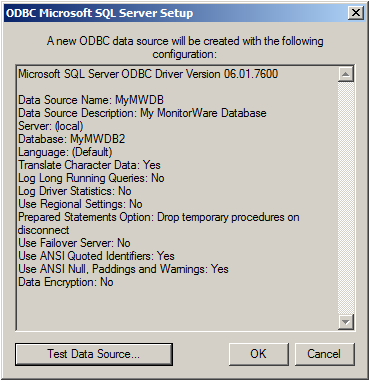
Click on “Test Data Source”, normally the following Window should be displayed:
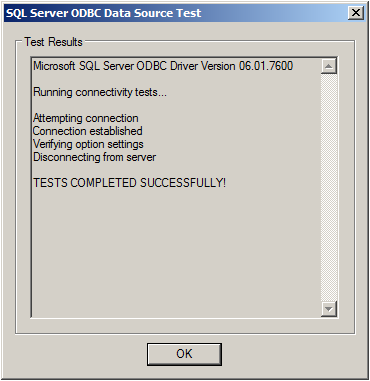
If not, go back and check your Settings, if yes, Click “OK” and exit the System-DSN Wizard.
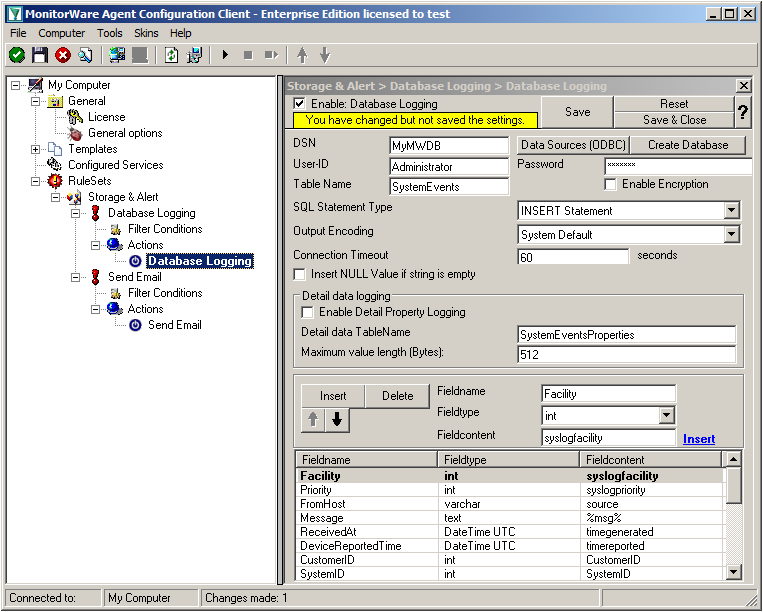
Now we are back in MonitorWare Agent. Insert the DSN for your database, User-ID and Password.
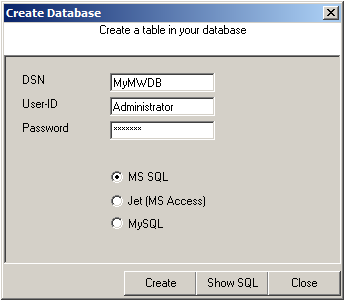
After that, click the “Create Database” button. We still need the tables that the log messages will be stored in. After clicking the button, a small window will open. Insert the DSN, User-ID, Password and choose the type of database you are using, in our case MS SQL. By clicking on the “Create” Button, the tables needed for the default database format of the MonitorWare Products will be created. After that, close the window.
Since we want to log all messages into the database, there is no need to set up any filters.
In the next step, we want to set up the Send Email rule. But since we only want error log messages, we need to set some filters. Click on the Filter Conditions. You will see the overview over the filters for this rule.
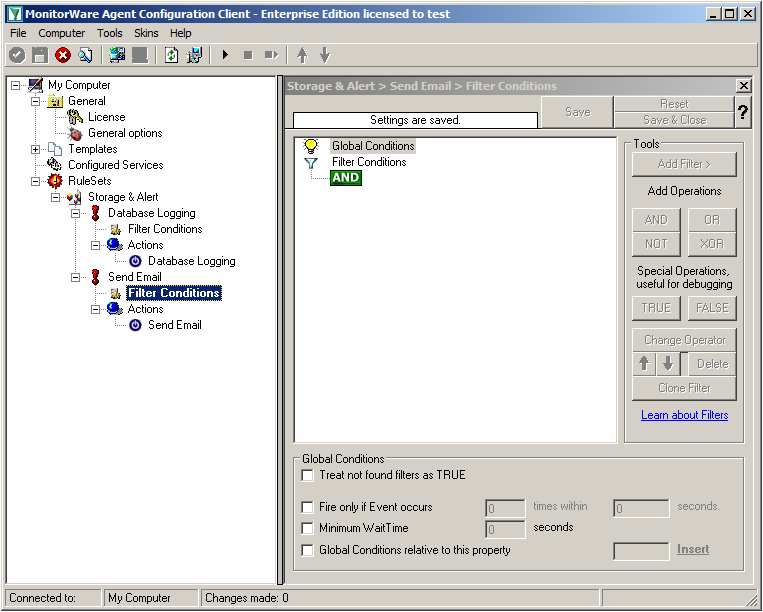
Right now, the view is empty except for a AND operator. Double-click it to change it into a OR operator.
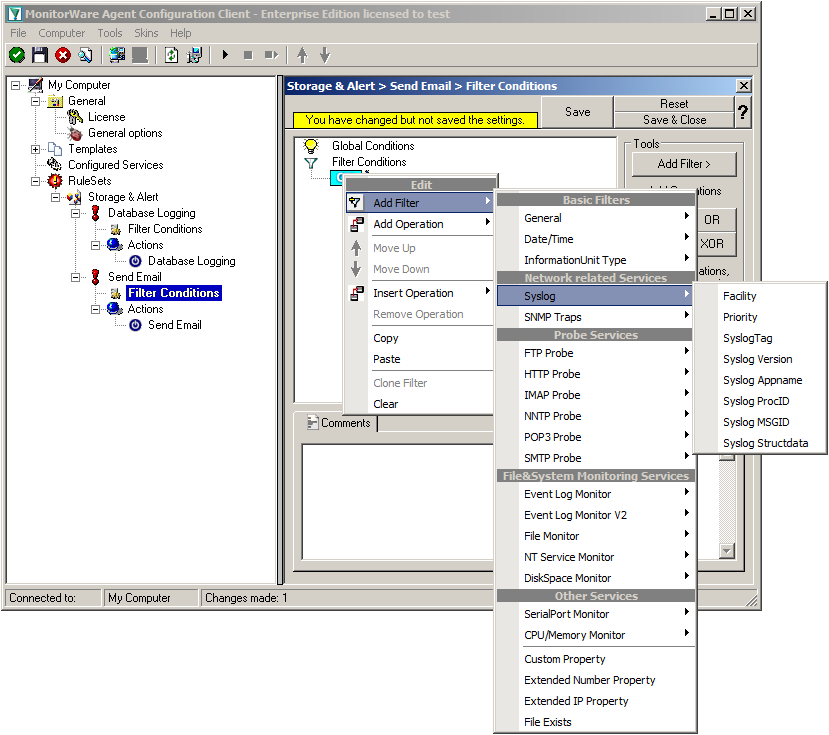
Right-click on the OR operator. A context menu will open. Go to Add Filter -> Syslog -> Priority.
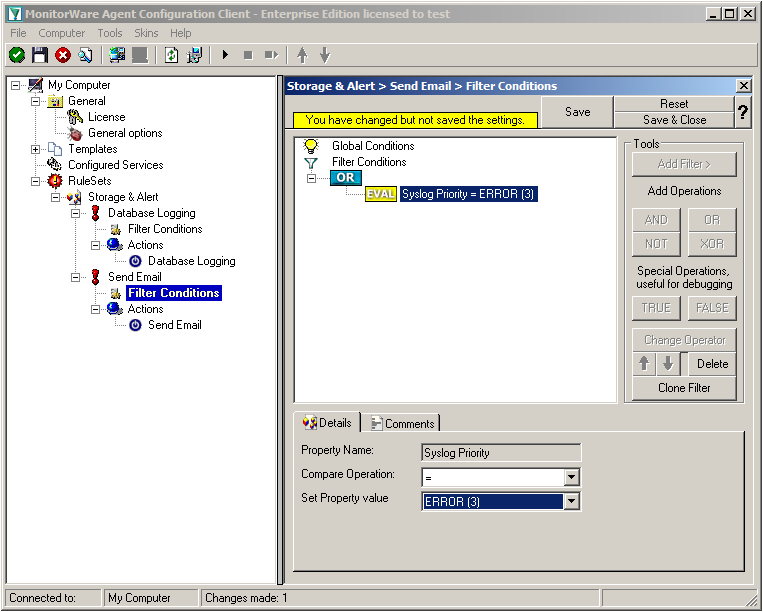
Click on the filter setting and change the property value to “Error (3)”.
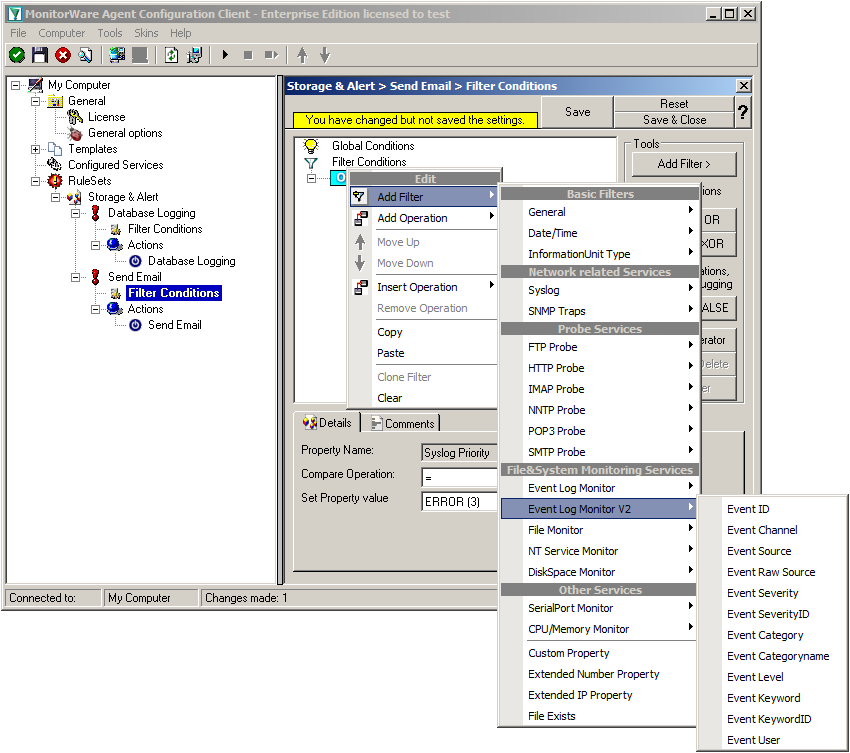
Again click on Add Filter -> EventLog Monitor V2 -> Event Severity.
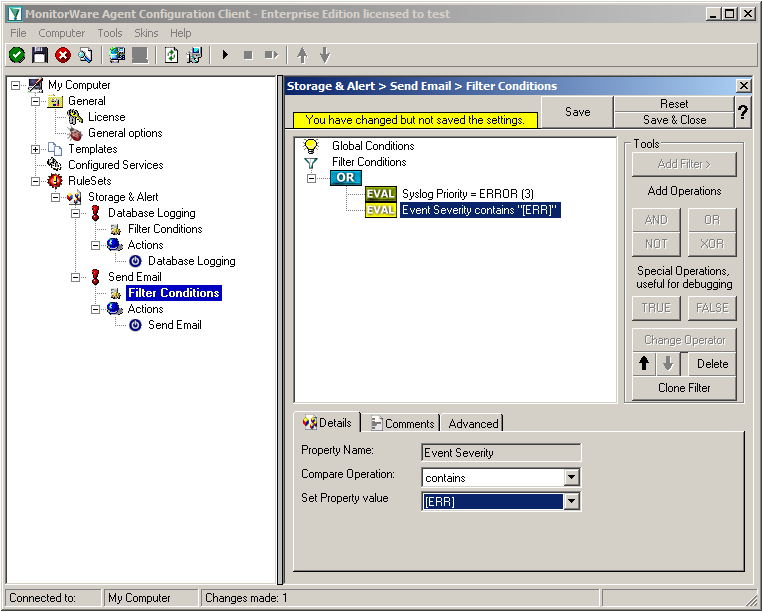
Click on the second filter setting and change the property value to “[ERR]”.
We are now finished with the filter settings. The filter will accept all log messages that are either of syslog proiority error or critical or Windows Event severity error. The OR operator ensures, that every of these cases will be accepted. When the messages are approved of fitting into the filter, the action will process them.
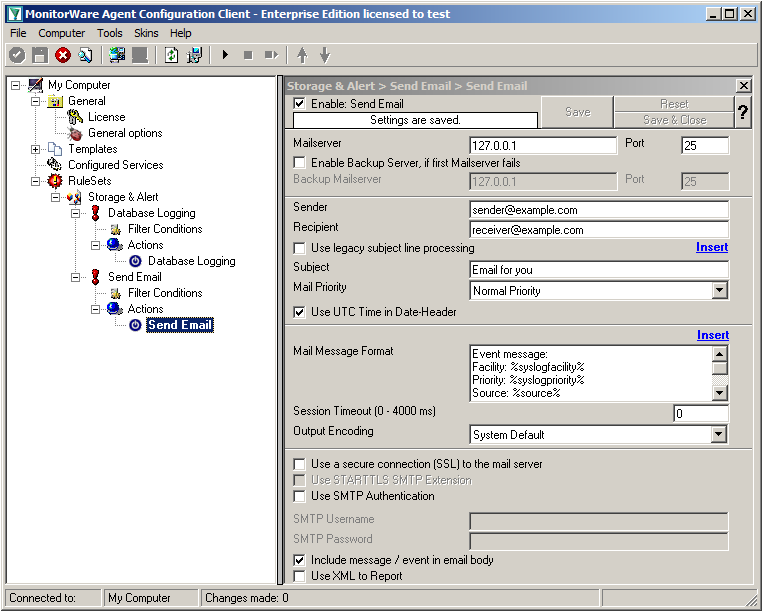
Click on the “Send Email” action now. You will see the configuration window on the right pane. Currently, there are only the default values in there.
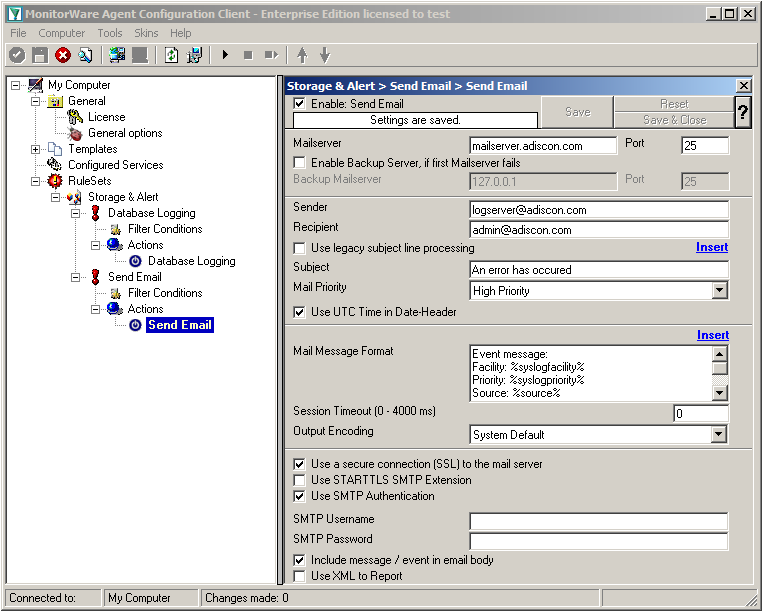
We need to change some settings here, like the Mailserver, Sender and Recipient, the subject and the Mail Priority. If necessary for your mail server, you need to change the authentification settings at the bottom as well. in our example we need SMTP Authentication for that. If you want, you could even enable the backup mail server.
Now we have all actions fully configured. It is now time to setup the configured services.
Currently, when clicking on Configured Services you will not see a thing. But we will configure the services now. Without them, MonitorWare Agent is not able to get any log messages. We will setup 2 Syslog Receiver, 1 EventLog Monitor and 1 File Monitor.
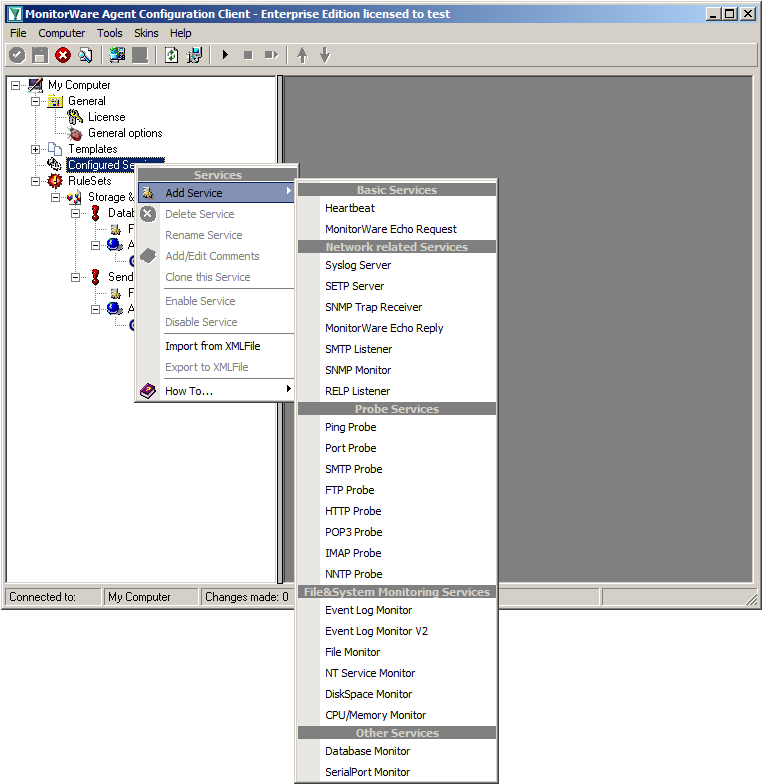
When right clicking on Configured Services a context-menu will open. By moving your cursor to “Add Service” you can see a list of Services, that may be configured. The list seems pretty long, but we basically need 3 services of them.
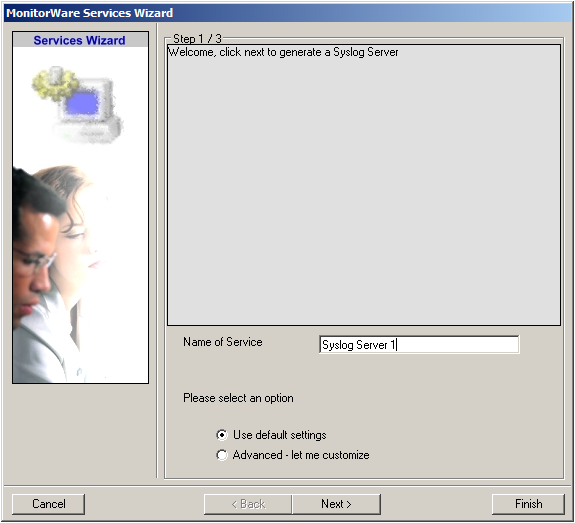
Click on “Syslog Server” first. The Services Wizard will open. Simply click on Finish for now. Repeat this again for Syslog Server, EventLogMonitor V2 and File Monitor.
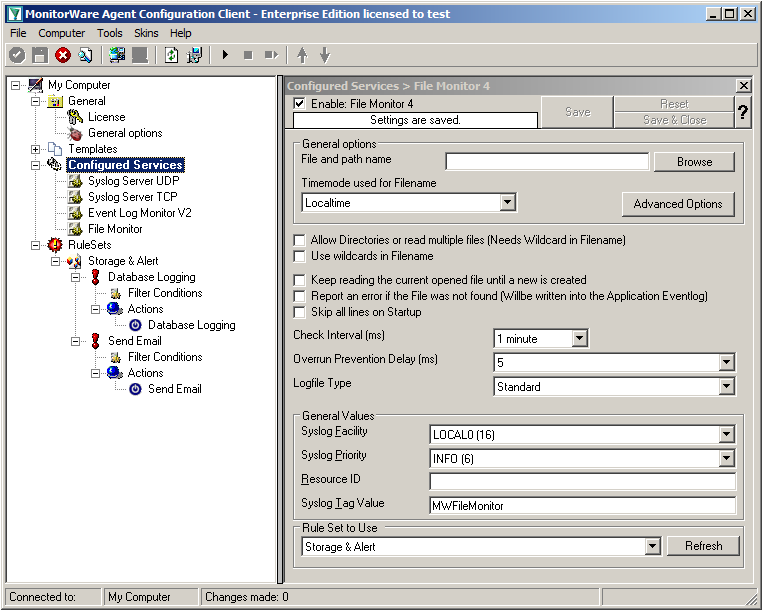
In the end, you should have a list with 4 Services. For our example I renamed the services by doing a right-click on the Service name I wanted to change and the choosing “Rename Service”. This was mostly to distinct the two Syslog Servers.
Settings for Syslog Server UDP
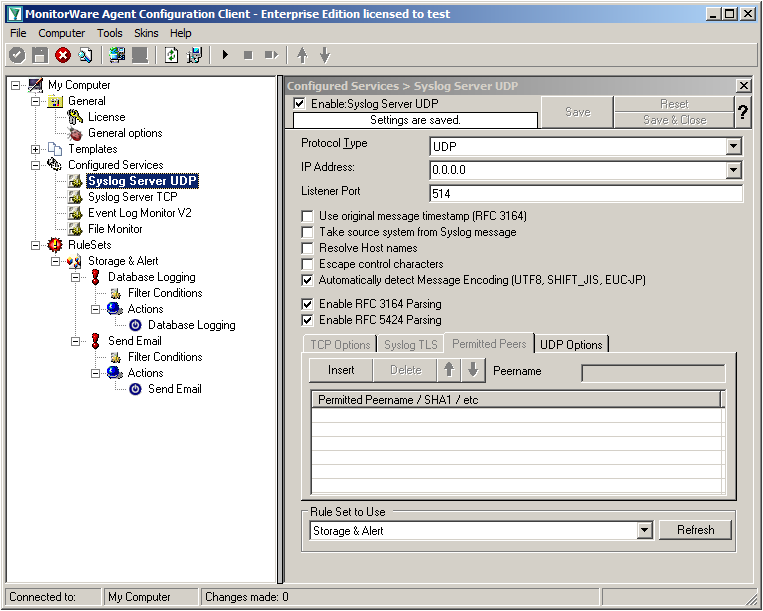
We can leave the “Syslog Server UDP” on default settings. It is already listening to UDP on port 514. The rest of the default settings is just fine.
Settings for Syslog Server TCP
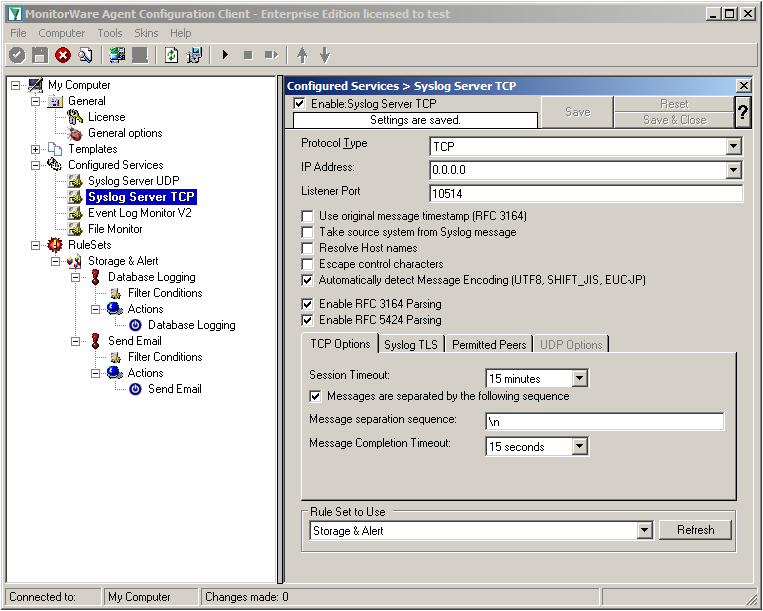
We will now go to the “Syslog Server TCP” now. Here we need to change several settings. Change the protocol type to TCP and the Listener Port to 10514. Further, we need to enable the option “Messages are separated by the following sequence” in the TCP options. It should look like this now:
Settings for Event Log Monitor V2
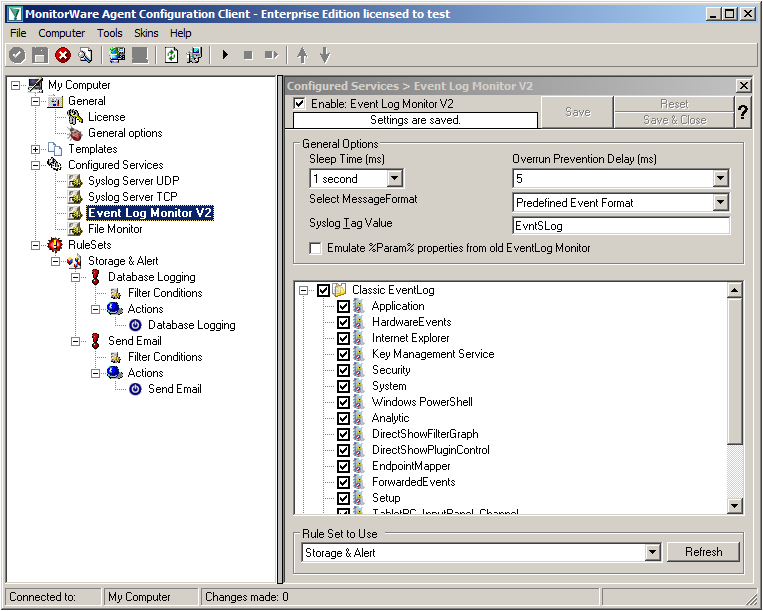
The Event Log Monitor V2 needs no additional setup. Again the default values are ok. If you want specific Event categories not to be stored, you can disable the options. But the basic format is sufficient.
Settings for File Monitor
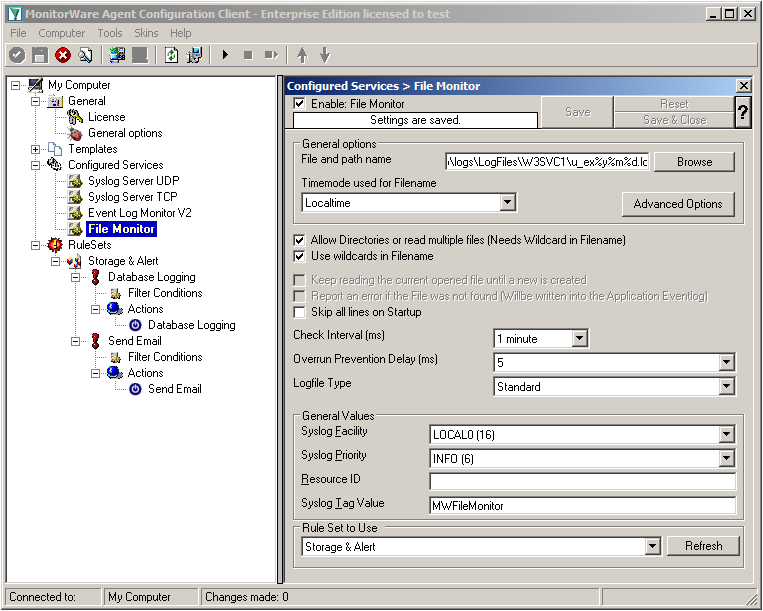
The File Monitor needs some additional settings. First, enable the option “Allow Directories or read multiple files”. You will see, that the use of wildcards will be automatically enabled and some other options completely being disabled.
Then we need to set the source files. For our example, we want to monitor the IIS logfiles. At the top of the File Monitor configuration you can see the option “File and path name”. There is a Browse button right next to it. Click it.
A windows explorer window will open, where you can choose the file you want to monitor. Navigate to the path C:\inetpub\logs\LogFiles\W3SVC1\. This is the location where the log files are stored. Please note, that the file location could be different when using another version of IIS. Choose the first file in the list. (Note: Daily Internet Information Server log files are named “u_exyymmdd.log”, with yy being the 2 digit year, mm the month and dd the day of month. To generate the same name with file monitor, use the following name “u_ex%y%m%d.log”.)
Set the Logfile Type to “W3C WebServer Logfile”.
Please note, that this step can be easily adapted for other log files (e.g. DHCP log files) as well.
We have now finished the configuration for our central server. It will now be able to receive syslog either via TCP (port 10514) or UDP (port 514), monitor the local Event Log as well as the IIS logfiles. Once more click the “Save” button to save the configuration (if not done already) and start the service. All log messages will now be stored into the database as they arrive/occur. Further, administrators will be alerted via email once an error occurs.
Created 2011-03-11 by Florian Riedl
This article will describe how to setup centralized logging in a hybrid environment. Basically, we will have various major steps, that show different configuration of several clients, which forward their log data to a central loghost. There, everything will be stored into a database and processed further for alerting.
To describe the situation basically, we want all machines on the network send their log data to a central syslog server (if possible). For the central log server we take a windows machine running MonitorWare Agent (www.mwagent.com). Here we can receive syslog, monitor local log files and the Windows EventLog. Data shall be stored into a database and several email alerts shall be configured. The other steps describe the configuration of simple Windows workstations and servers, as well as Linux servers.
For TCP transmission we will use port 514 (default) for UDP and port 10514 for TCP. We want to use TCP mainly, because it ensures the transmission of the syslog messages. This is due to UDP being connectionless and thus it can occur (and will) that messages get lost.
The Client machines in this example consist of several different types of machines. We have regular Windows Workstations. Here we will use EventReporter (www.eventreporter.com). In addition to our central server, we have some other Windows Servers which will get MonitorWare Agent as well and some Linux machines which have rsyslog (www.rsyslog.com) installed. These machines will send their log messages via TCP syslog to the central server.
Additionally to these clients, we will mention some other devices and appliances (just roughly), like firewalls, switches and routers.
This is the first and biggest step. We will configure the central server first. The reason is simple. If this is already running, we can setup the clients and it will directly start logging everything. We assume, this is a Windows Server where MonitorWare Agent is installed. The central log server shall provide the following functionality:
In step 2 we will set up the regular Windows clients. These are usually the workstations the people work on. We will use EventReporter here. It can pull all log messages from the Windows EventLog and forward them via TCP syslog. Thus the following functionality is mandatory:
Now we will configure the other Windows servers. Again, we will use MonitorWare Agent because it has the most functionality. We need the following functions to be setup here:
Now we get to the Linux servers. Here we need to use a completely different product – rsyslog. For a first-time user, this might look a bit strange. The configuration we want to have here needs the following:
This is rather just a note on other devices and appliances that are not yet covered. Often devices (like routers, firewalls or switches) have the possibility to send log data to a syslog server. Usually, this only works via UDP and some machines are even capable of sending logs via TCP. Since there is such a huge mass of different systems and devices, we cannot give correct steps for everything. Please refer to the user manual that came with the device or contact the manufacturer for information about how to configure the devices for sending syslog.
If you already know how to configure it, let it send it’s log messages to the central server on port 514 for UDP or (if possible) port 10514 for TCP.
We now have a setup that stores all the log data that machines on the network will generate to a central database for storage. Most of the clients on the network send their log data securely via TCP to the central log storage. Some machines were rather quick to set up, others needed more effort. Usually the effort rises with the amount of features that will be used. Thus we thought of this setup to be quite simple.
If you have any remarks or ideas of improvement for this guide, please let us know and send an email to info@adiscon.com.